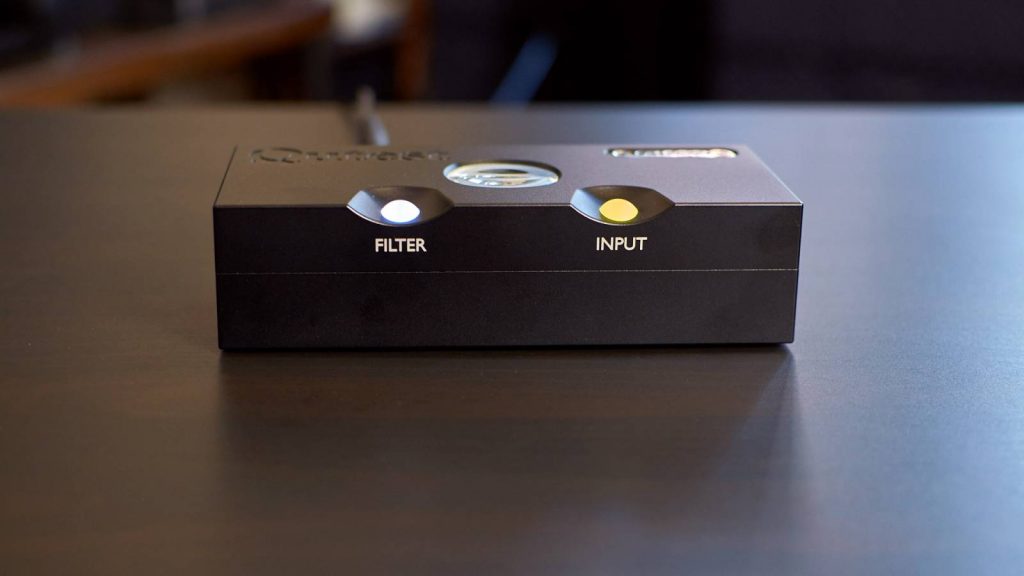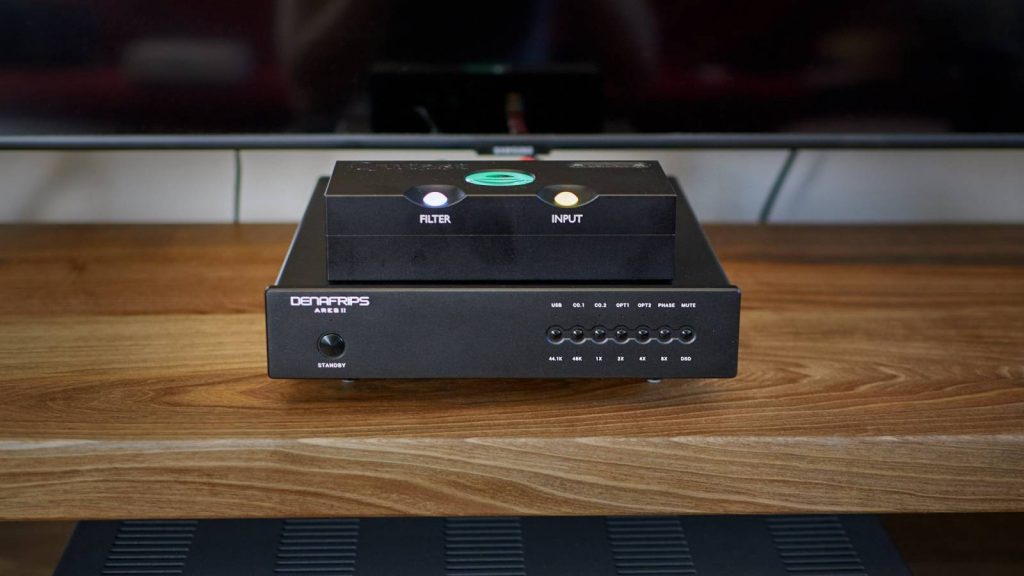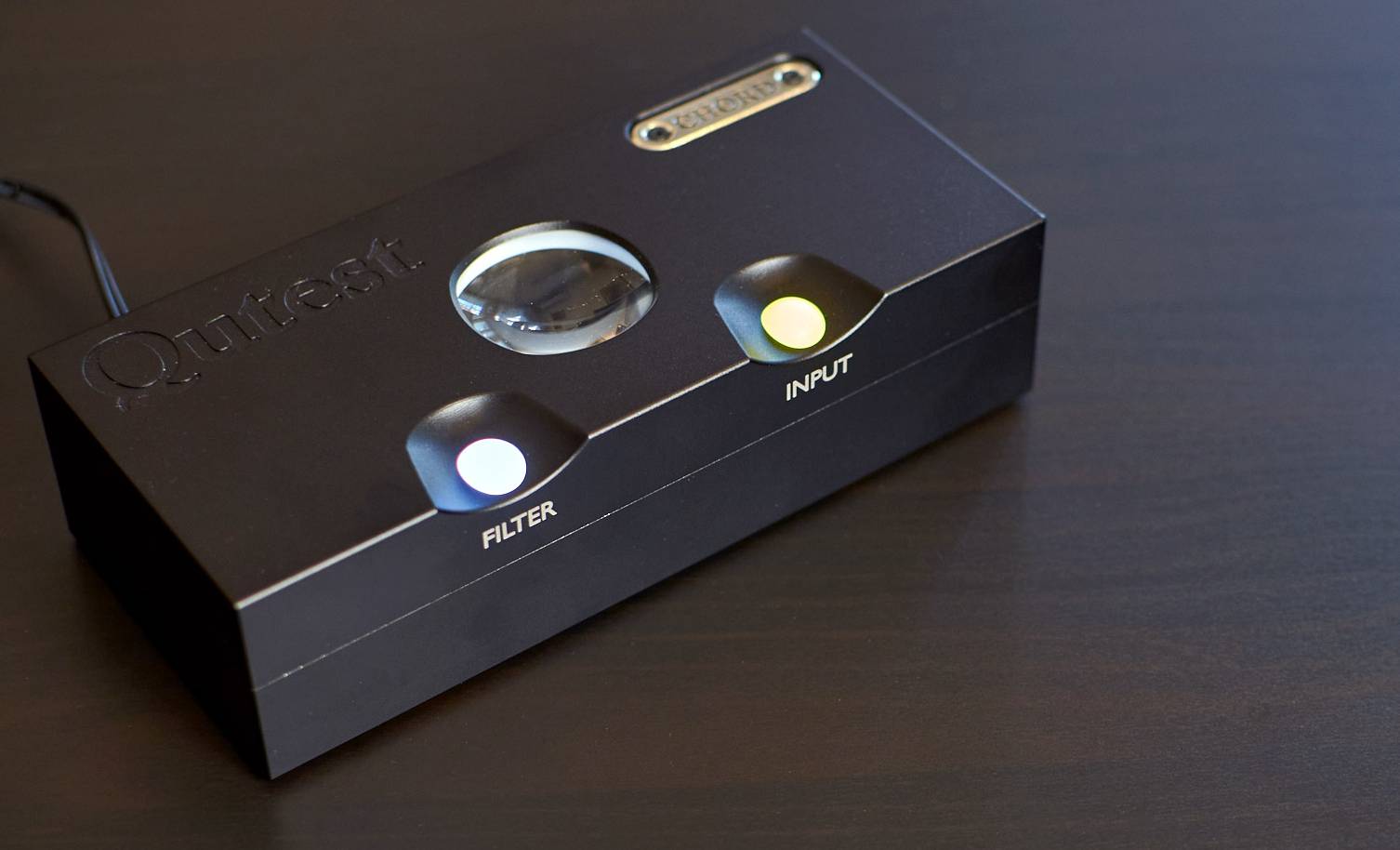Chord Qutest has a long line of praises and five stars reviews, but it has been on the market for some time now. Do these stars still hold and is it as good a preposition today, in 2021, as it once was. Keep reading this late review to find out.
Build and Connectivity
Chord Qutest is not big but it’s made of thick aluminium and feels very sturdy. Its looks are a matter of taste but it’s hardly going to leave anybody indifferent. First of all, there is no display on board, all information about inputs, filters, and sample rate of files being played is given through different colors of two ball-shaped buttons and one circular glass window into the device. This means that once powered-on Qutest becomes very colorful, and feels like something cheerful that came out of the animated movie for kids. Chord didn’t include any kind of remote control, so you’ll have to use mentioned ball-shaped buttons and follow color changes. The user manual is basically a must for a time being, at least until you learn what each button does and what each color means.
On the back, we find four digital inputs. There is a USB one, an optical SPDIF one, as well as two BNC SPDIF inputs. I have to say that I would personally rather see one of the BNC turned into an RCA digital input as these are much more widespread throughout the industry (even though BNC is technically a better connector, having an RCA as an option is a matter of convenience). When it comes to analog outputs, there’s a pair of fixed-level RCAs and that’s it.
Finally, Qutest is powered by 5 VDC over a micro-USB connector. A small switching power supply is provided in the box, but we’re going to come back to its significance later in the testing section.


Features
As most of you are probably already aware, Chord doesn’t use off-the-shelf D/A conversion chips made by manufacturers such as Sabre, Asahi Kasei, Burr Brown, etc. Instead, they fully design their own DAC based on FPGA and digital filtering in-house. That said, Chord Qutest will accept any PCM up to 768 kHz and DSD up to DSD512, which are higher sample rates than you’ll ever need. All other specs that you might be curious about are provided in the table below the review.
As previously mentioned, the analog output is fixed. That said output voltage is selectable and you can choose between 1 V, 2 V, and 3 V. I’ve mostly used it with 2 V out as that’s the most common DAC and CD player voltage nowadays. However, it’s worth noting that depending on the amplifier the DAC is attached to and its sensitivity, some of these voltage levels can sound different in different systems. Because of that, there is no universally best choice among these three, and it would be advisable to try each option for yourself.
Finally, there are several digital filters you can choose from, ranging from the most neutral to the warmest one. I personally preferred the default, neutral, one. Again, you should try them for yourself and find the one that suits you the best.
Testing and Sound
Even though I listened to it in several different configurations in two different systems, for the biggest part of the critical listening test, Chord Qutest was connected to the Lindemann Limetree Bridge digital streamer, while its output was feeding Hegel H90 integrated amplifier and KEF LS50 speakers. An important thing to mention here is that Chord Qutest was powered with Allo Shanti linear power supply, and all of the impressions from now on are observed that way. Using included freebie switching power supply will degrade sound quality, and you can read more on it in the comparison section down below.
To put it simply, Qutest sounds precise and clean. Starting with the bassline, it definitely created some of the best behaved and tidy-sounding bass notes. Speed and control are outstanding and note edges are well defined without any traces of warming or blooming. Now copy-paste this to the rest of the frequency spectrum and you’ll get the picture – every tone is etched in its place with masterful precision, clearly separated from other tones and instruments. That said, I find it tonally even, there is no excessive brightness or any kind of artificial edginess that I can hear. It simply prioritizes precision and order above warmth and any kind of sweetness. In doing so, Qutest is capable of digging an admirable amount of tiny details. Singers opening or closing their lips, squeaky chair in the background of the live recording, etc. If it’s in the recording, this DAC will retrieve it for you. The dark background is only helping with exposing all these details more easily.
Soundstage is another thing Chord Qutest does really well. That dark background helps with the sensation of a deep soundstage. Vocals and instruments are then pinpointed inside of it and well separated, with enough empty space in-between. When it comes to creating this virtual soundstage space and arranging things inside of it, Qutest is probably the best DAC I’ve so far tested in my own system.

Comparison and Power Supply Importance
Naturally, I compared Chord Qutest to my own Denafrips Ares II, an R2R DAC with a different sound signature. Compared to Qutest, Ares II sounds somewhat hazier and less precise. The bassline is denser but not as well defined, and a similar impression persists throughout the rest of the frequency spectrum. On the upside, tone timbre feels somewhat richer through Ares. To put it in other words – Qutest sounds tidy, controlled, defined, and orderly. It also develops a slightly deeper soundstage with a darker background. Its tone timbre however feels slightly leaner. Ares II sounds a bit slower, with the edges of each tone less defined and not as well separated. But vocals and instruments do sound fuller and with richer tone timbre.
Listening back and forth, I found myself preferring Ares II for simple musical arrangements consisting of a singer and just a few instruments. Norah Jones or Leonard Cohen would be good examples of such artists. In such an uncluttered environment, Ares sounded more soulful with bolder and richer vocals. But as soon as I would play a busier track with more instruments and tones fighting for space and my attention, I prefer how Chord Qutest arranges everything in order with greater skill.
Now, this comparison wouldn’t be complete without mentioning that Chord Qutest was fed with Allo Shanti linear power supply at all times. Going back to the switching power supply included in the box, sound degrades significantly. Some of the clarity is lost, and some of the background darkness too. The soundstage becomes flatter, and at that moment Qutest basically losses all of its advantages over Ares II that incorporates a linear power supply inside the DAC itself. At this point, I wouldn’t think twice before choosing a more affordable and richer-sounding Ares II. Chord can claim that their DACs are not influenced by the power supply that much, but in reality that is just not the case, and I would highly advise anyone who purchased Qutest to add a higher quality power supply as soon as possible. Otherwise, you are not going to hear what this DAC can really do.
Conclusion
If you don’t mind its quirky design, Chord Qutest is a great-sounding product, especially if you like clean and orderly-sounding devices. The only thing I’m not that fond of is that it’s still priced at around 1450€ or $1700, but for that price, you get a cheap switching power supply that’s limiting its performance. So count in another two hundred bucks for a decent one if you really want to hear it sing. At that point, we’re mighty close to two thousand US dollars. What I’m saying is this, even though I really like the sound of Chord Qutest, at its full retail price that’s still holding steady after few years, I don’t find its price to performance ratio that appealing. But if you would to get it at some kind of discount, let’s say closer to 1000 € or 1200 USD, I would be much happier to recommend it.
| CHORD QUTEST – CHARACTERISTICS |
|
Materials: Precision machined aluminium casing with polycarbonate buttons and glass viewing portal. Available only in Jett Black. |






Hello,
I also have a Qutest. I would like to add an Allo Shanty linear power supply, may I check with you which rail ( 1A or 3A ) shall it be connected to the Qutest? Thanks.
Charlie
Each of these rails has enough power. If you don’t use second one for anything then connect Qutest to 3A one. But if you plan to power some sort of streamer too, chances are it will need that more powerful rail so you just switch Qutest to the 1A one.
The higher current 3A would be best.
stopped reading when author started prattling on about the PSU. of course Chord would sabotage a multi thousand dollar product with an inadequate PSU. guffaw. just more of the audiiophile hoodoo as practiced by engineering illiterates.
Ken, it’s up to you to choose whom to believe, what to read, and how to communicate in the public domain. I can only say that even a fifty or hundred thousand dollars products are not always perfect unless you’re starstruck and take the manufacturer’s word for granted.
Also, this particular illiterate just happens to have an electrical engineering degree (specialized in precise electrical measurements and biomedicine). All the best
This is a great review. Coincidentally I own both the Qutest and the Ares II and concur with just about everything you wrote on the two. Also, as an Aerospace Engineer, I can attest to the benefits of a linear power supply over a switching power supply for this application. My one and only complaint about the Qutest is the use of Micro USB for the power port. They should use something more robust like USB-C in future models.
Agreed, Micro USB is my least favorite too and most prone to fail after prolonged use. USB-C is not a new tech anymore, everybody should be adopting it in the upcoming products.
Srboljub, I bow to you! I’ve been watching a few of your reviews in YouTube recently, and I like the way you evaluate and review products. I hope people like Ken would think twice before rattling that way.
I am using it with the iFi iPower X, but didn’t compare it to a LPS.
iPower X is a really good power supply. I use a 12V version for various stuff.
Hi Sojanovic,
Have you ever compared the iPowerX vs Shanti for the Qutest? just curious…
Nice review. i find it interesting though that one has to tout their credentials to substantiate they can hear. Kind of like an optometrist telling you he can see better than you.
I’m not sure what part of this review looked like touting my credentials.
I own a Chord Qutest. I love it. I was never troubled by the inexpensive power supply. To me, it sounded great with it, though I wasted no time bringing in a DC power brick.
On first blush, it didn’t rock my world. I had enjoyed the D90SE it replaced. I heard no change in tonality. I just used it and forgot about it as I let it achieve some kind of organic burn-in.
Then one day, I started hearing stuff I’d never hear before on tracks I’d heard for decades. I’m talking about subtle stuff – like a bass line that was segmented all along, or the undulating tones of an electric keyboard, or the tamboreen I’d somehow missed.
I set it aside, when I purchased the Ferrum Wandla, to complete the trio with the Oor and Hypsos combo. I thought about selling it to offset the cost of the Wandla. I’m glad I didn’t. I love what it does, though I can’t part with the Wandla, either.
I’m hoping to eventually pair it with the M Scaler. For now, I’ve focusing on those parts of my chain that are within reach. I’ve added Sbooster as a clean but dynamic power supply. I’ve also replaced my MacBook Pro with an Eversolo DMP-A6. It’s the best I can do for now, though it doesn’t replace all the hours I spent listening to the radio through crappy speakers on a noisy school bus.